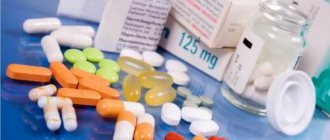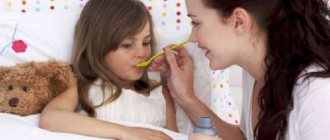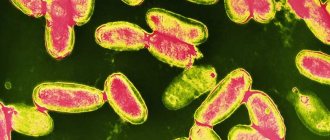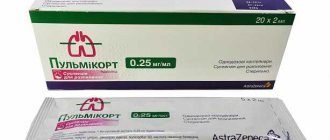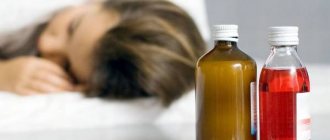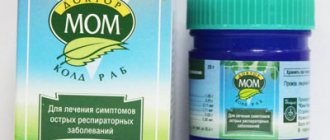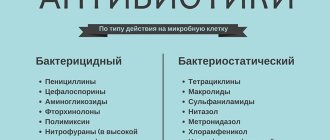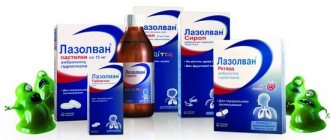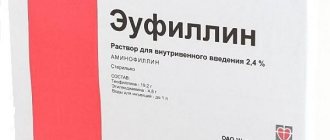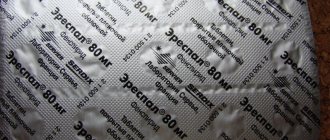Most respiratory diseases such as bronchitis, pneumonia, tracheitis require complex treatment, including antibacterial or antiviral therapy, antipyretics and antihistamines, immunostimulants and immunomodulators. Pathogenetic treatment is aimed at reducing signs of inflammation, bronchodilation, restoring the patency of the respiratory tract, as well as liquefying and removing sputum. For this purpose, patients are prescribed expectorants. This is a group of drugs that ensure the removal of bronchial secretions from the respiratory tract.
Healthy people constantly produce a mucous secretion designed to moisturize and cleanse the epithelium of the respiratory tract. With infection and inflammation of the respiratory tract, the activity of the cilia of epithelial cells decreases and sputum production increases. It becomes viscous and difficult to separate. To cope with this problem and eliminate a productive cough, medications that help thin and expectorate sputum will help. They restore the functioning of the ciliated epithelium and accelerate the movement of tracheobronchial secretions.
Drugs in this group are divided into 2 large subgroups:
- Secretomotor agents that directly stimulate expectoration.
- Mucolytics or secretolytics , thinning sputum.
Expectorants are intended for the treatment of productive cough with viscous and thick discharge, which occurs when the bronchi, bronchioles, lungs, trachea are affected, as well as bronchial asthma, atelectasis, COPD and other diseases.
Mucolytic and expectorant drugs are auxiliary drugs that make the patient’s life easier, but do not eliminate the cause of cough. They should be used only in combination with etiotropic antimicrobial therapy.
Mucolytics thin the thick bronchial secretions, have a mild anti-inflammatory effect and prevent mucus from sticking to the walls of the respiratory tract.
Features of the action of mucolytics for inhalation
The products are available in different forms. For mild and moderate diseases, tablets, syrups, and drops are used. The medicine enters the stomach, from there it is absorbed through the tissues into the blood, and is localized in pathological places. For severe diseases of the lower respiratory tract, the effect of tablets is not enough. Inhalers convert liquid medications into an aerosol and deliver active ingredients to the lungs and bronchi. The concentration of active components in this case is higher, so the therapeutic effect occurs much faster.
Mucolytics are compatible with:
- antibiotics;
- antiseptics;
- hormonal agents;
- bronchodilators;
- vitamins;
- enzymes of the digestive system;
- analgesics.
Some of them can be used simultaneously. In most cases, it is recommended to take a break of 1-2 hours between inhalations of different agents.
Mucolytic agents for inhalation
Inhalations with saline solution and mineral water can be done independently when the first symptoms of a cold appear. Mucolytic solutions are used only after prescription by a specialist.
"Trypsin." Dilute one ampoule of the drug with 3-5 ml of saline and pour it into the nebulizer tank. To prevent hoarseness, do not increase the dosage of the product, but after the session, gargle with warm boiled water.
"ACC." Before filling the nebulizer reservoir, dilute the drug with saline in a 1:1 ratio. Do inhalations 2-3 times a day between meals. The duration of the procedure is 10-15 minutes, the maximum course of treatment is 10 days.
Effective mucolytics for nebulizer
All medications from this group act the same way - they thin mucus and stimulate its excretion.
- Lazolvan. The most common cough remedy. Prescribed for adults and children. 1-3 procedures are performed per day depending on the severity of symptoms. The drug is well tolerated and rarely causes side effects. Often included in complex therapy.
- Ambroxol. Mucolytic agent for inhalation of domestic production. It is an analogue of Lazolvan. The active component is a substance with the same name “ambroxol”. According to buyers, it is less effective than the original and more likely to cause side effects. The instructions for use are identical. Breathing procedures with Ambroxol are done up to 3 times a day.
- Ambrohexal. Available in a bottle with a dropper in the form of a solution. Used for oral administration and inhalation. Acts on the basis of ambroxol. Allowed for use by adults and children from 1 year of age. Single dose 2-3 ml. Immediately before use, dilute with saline solution. Breathing procedures are carried out twice a day.
- Pulmozim. The active component of the mucolytic is dornase alpha. Available in solution form. Contraindications are the presence of individual intolerance, children under 5 years of age, pregnancy in the first trimester, breastfeeding. Rarely causes adverse events. It combines well with other medications for the treatment of cough and respiratory failure, but mixing them in the nebulizer chamber is prohibited. The interval between procedures is maintained at 1-2 hours.
- Acetylcysteine. Mucolytic, expectorant, antioxidant medication. Allowed for use by children. Shown to be highly effective in the treatment of diseases of the upper and lower respiratory tract.
The list of medications can be continued, but in most cases these are prescribed. If there is an individual intolerance to the active ingredients of one drug, another one with a different active ingredient is selected.
Contraindications and side effects
Each mucolytic agent has instructions for use, which indicate contraindications for its use. General prohibitions include:
- pregnancy (first trimester);
- intolerance to the components of the drug;
- ulcers and bleeding in the digestive tract.
Mucolytics should not be taken simultaneously with cough suppressants. Otherwise, a significant part of the sputum will remain in the tissues of the bronchi and lungs. Stagnant mucus is a favorable environment for the development of secondary infections.
Mucolytics in the form of syrup are prohibited for people with diabetes.
When treating cough in bedridden patients, the doctor reduces the dosage of the mucolytic agent. Such patients find it difficult to cough, so a “flooding effect” of the lungs may occur. In this case, special suction is used to remove mucus.
Inhalation with herbal mucolytics in a nebulizer
Herbal medicines based on plant extracts are used as auxiliary medicines. They do not have powerful mucolytic properties, so they cannot be considered a full-fledged medicine. Most often, inhalations with Mucaltin are prescribed. The drug is available in tablet form. To prepare a solution for inhalation, it must be dissolved in saline solution. Up to 5 inhalations are given per day.
Herbal mucolytics in a nebulizer are used if the use of powerful medications is prohibited. Mucaltin is often prescribed to young children, pregnant and lactating women. The situation is similar with other herbal medicines based on plant extracts with expectorant and thinning properties. Another common product based on plant extracts is Insti. Available in granule form. Used to prepare a solution for breathing procedures.
Phytotherapy
Some medicinal herbs have an expectorant effect and clear the bronchi of mucus. Official medicine allows the use of these herbs for wet coughs. You can purchase them at the pharmacy chain and use them strictly according to the instructions.
Expectorant herbs include:
- Plantain,
- Altey,
- Coltsfoot,
- Thyme,
- Licorice,
- Sage,
- Calendula,
- Chamomile,
- Thermopsis,
- Oregano.
These herbs irritate the gastric mucosa and brain centers, and then reflexively activate the mucous glands in the bronchi and the contractility of the bronchial muscles. Thanks to this, sputum becomes liquid and abundant, it moves faster through the respiratory tract and leaves the body.
Breast mixtures are prepared from medicinal herbs or brewed separately. Decoctions, infusions, syrups, herbal teas and drinks provide a good therapeutic effect. Most people suffering from productive cough choose natural remedies and confirm their high effectiveness. Modern pharmaceuticals produce a huge number of herbal medicines based on medicinal herbs.
"Gedelix", "Gerbion" and "Prospan" are cough syrups of plant origin based on ivy. They dilute sputum, relieve muscle spasms from the bronchi, and remove liquid secretions. These remedies can be used for both dry and wet coughs.
- "Doctor Theis" is a syrup with plantain that has an expectorant effect for all types of cough. It reduces signs of inflammation, stimulates the immune system, relieves spasms in the bronchial muscles, kills germs, and soothes throat irritation. The drug is used as an addition to basic drug therapy.
Thyme-based products gently and effectively thin mucus and promote its removal from the body. These include the drugs “Bronchicum”, “Bronchipret”. They reduce swelling of the mucous membrane and increase the lumen of the bronchi, alleviating the symptoms of a painful, paroxysmal cough. “Pertussin” is a cough syrup known to almost everyone since childhood. It has an expectorant, antimicrobial and analgesic effect and promotes rapid evacuation of bronchial mucus.
- “Thermopsis tablets” are traditional, inexpensive cough medicines that thin and remove mucus. "Thermopsol" is a similar product that is suitable for both adults and infants, which speaks in favor of its safety. This drug stimulates the respiratory center in the brain, stimulates the production of mucus in the bronchi, has a weak anti-inflammatory effect, increases the tone of the smooth muscles of the bronchi and kills pathogenic bacteria.
Preparations obtained from marshmallow root combine effectiveness and cost-effectiveness. The most common among them is “Mukaltin”. This is a medical drug used to treat respiratory diseases as a secretolytic. It stimulates the activity of the ciliated epithelium, the secretion of mucous glands and the peristalsis of the bronchial muscles.
Combined herbal remedies - “Stoptussin”, “Amtersol”, “Pektusin”. Drugs in this group eliminate frequent coughing attacks and make it productive. They have an analgesic effect, are well absorbed by the body and are quickly absorbed. Linkas increases productivity and reduces cough intensity. This drug has an expectorant, bronchodilator, antipyretic, sedative and antimicrobial effect. "Linkas" copes well with even the most painful cough.
Rules for inhalation through a nebulizer with mucolytics
The course of therapy begins after confirmation of the diagnosis. A compressor nebulizer is used as an inhaler. The device works with all types of medications, including mucolytics. To ensure the effectiveness of the procedure, you need to follow some rules.
- Immediately before inhalation, you need to prepare a solution by diluting the product with saline solution. It is prohibited to use distilled or boiled water .
- A maximum of 4 ml of ready-made mucolytic is poured into the nebulizer chamber. In most cases, the medication is diluted with saline in equal proportions. But if the medications are prescribed 3 ml at a time, only 1 ml of saline should be added.
- It is recommended to do inhalations in the morning to remove accumulated mucus overnight, 2 hours before bedtime. Immediately before bedtime, breathing mucolytics is prohibited. Firstly, the procedure intensifies the cough, and secondly, in a lying position it becomes difficult to remove sputum, and congestion occurs.
- In case of severe cough attacks, bronchodilators are initially inhaled to relieve spasms; after 1-2 hours, mucolytic drugs are allowed to be used.
- The course of therapy lasts on average 7 days. If no improvement is observed during this time, the prescriptions are reviewed.
Expectorants are administered through a nebulizer when it is difficult to remove mucus from the bronchi and lungs. As soon as the condition returns to normal, you can switch to tablets and cough syrups.
Mucolytic agents for children
Gentle plant-based mucolytics are used to treat children.
"Doctor Mom" The main substances of the drug are extracts of medicinal plants. Kids enjoy taking sweet syrup 3 times a day after meals. Older children can suck on hard cough drops.
"Mukaltin." The drug contains tartaric acid to thin sputum, marshmallow extract for anti-inflammatory effects, and potassium bicarbonate to stimulate secretory function. The medicine can be given to children over three years of age.
Price market
On the modern pharmaceutical market there are domestic and imported drugs. Medicines are sold through a network of pharmacies and the Internet.
| Name | Manufacturer | Minimum price in rubles |
| Mukolwan | Ukraine | 100 |
| Mukaltin | Ukraine | 80 |
| Ambroxol | Russia | 48 |
| Lazolvan | Italy | 150 |
| Ambrohexal | Slovenia | 100 |
| Ambrobene | Germany | 97 |
| Pulmozyme | Switzerland | 1400 |
The shelf life of mucolytics is on average 2 years from the date of manufacture. When diluted with saline, the medicine must be used within 24 hours. It should be stored in a dry place, away from direct sunlight.
It is important to know
In no case should antitussives be mixed with expectorants and mucolytics, so if one is prescribed, you should not drink the other at the same time. The exceptions are drugs that are a combination of all three of these effects, but this is a completely different case and, as they say, another story.
If a person is sick with the flu or a cold with a dry cough, neither mucolytics nor expectorants are indicated for him, which, however, was also mentioned above. By the way, as a rule, they first take mucolytics to make the sputum less viscous, and only then move on to expectorant medications. And if such medications are prescribed, then it is very important and simply necessary to consume liquids as often as possible - tea, fruit juice, compote, juice, and, of course, ordinary water.
Reviews
Larisa: “Lazolvan always helps us out. I tried to replace it with Ambroxol, Mucolvan, the effect was not the same. This drug puts you on your feet in three days.”
Olga: “Mucolytics are prescribed through an inhaler for obstructive bronchitis. If it is a normal wet cough, take tablets. We always buy Lazolvan. Ambroxol once gave me a severe coughing attack, now I’m afraid to buy it.”
Anastasia: “Mucolytics through a nebulizer are prescribed for severe bronchitis. When breathing and general well-being improve, they switch to syrups and tablets.”
What does expectorant mean?
The cough can be wet or dry. If the cough is wet, this means that in our respiratory tract, lungs, bronchi - in general, in the respiratory organs - sputum has accumulated, in which all kinds of bacteria have found a habitat. And the longer phlegm stays in our body, the more chances microbes have to spread throughout it. In order to remove phlegm, you need to cough it up - those same pieces of yellowish mucus that come out during a wet cough are phlegm. And special drugs called expectorants help to cope with it. We will talk about them further.
The need to take expectorants
Every person has had a cough since childhood. Typically, this disease develops in the autumn and spring, and spreads especially actively in schools and kindergartens. Even if we are talking about a physiological cough, expectorant medications may also be required.
In a healthy body, the glands of the bronchi and trachea produce glandular secretions, which help the organs of the respiratory system resist damage from viruses and bacteria. It also helps to expectorate small foreign particles that enter with the exhaled air.
Sometimes a person does not pay attention to how he swallows about 100 ml of mucus produced per day. But as the infection develops, the volume of sputum produced increases to 1.5 liters per day.
It becomes an excellent breeding ground for microbes. At the same time, the body tries to get rid of the secretion, causing coughing. And expectorants help dilute the secretion, making it easier to remove from the body.
Expectorants are required to reduce the viscosity of sputum and increase the speed of its removal from the respiratory system, and most importantly, from the lumen of the bronchi.
A certain amount of mucus - approximately 100 ml - is constantly in the respiratory tract. This secretion plays a protective role and, under normal conditions, does not cause concern to a person who swallows a large portion of it throughout the day.
With inflammation of the respiratory system, sputum becomes viscous and its volume increases. Due to inflammation, specific cells that line mucous surfaces are unable to push through mucus.
Thus, the secretion accumulates and is difficult to separate. Thick sputum is an excellent breeding ground for pathogenic microorganisms. Also, during stagnation, normal gas exchange and respiratory processes are disrupted, and coughing increasingly irritates the respiratory tract. To alleviate the condition, it is necessary to use effective expectorants that dilute mucus - they reduce its viscosity, helping to remove it faster.
Other effective methods
To treat bronchitis in children and improve sputum discharge, folk remedies are used, for example, warm milk with the addition of butter or goat fat, soda; a mixture of honey with radish, onion or garlic juice; puree syrup made from bananas, boiling water and sugar. You can give your child infusions of medicinal herbs or use them for steam inhalations.
The expectorant effect is:
- plantain leaf, coltsfoot;
- herb wild rosemary, thyme;
- marshmallow roots, licorice;
- breast fees.
In addition to medications and traditional medications, postural drainage is very effective. After this procedure, bronchial secretions are released much more actively. On the eve of the procedure, it is necessary to give the little patient expectorants, if age permits, perform inhalation, and give him a good drink. During the execution, the head of the lying child should be lowered.
The postural drainage technique involves alternating actions between the massage therapist and the patient, but for young children it has its own characteristics; it is dominated by tapping and vibration massage. Older children should do breathing exercises and cough. In children, you have to induce a reflex cough by pressing on the root of the tongue. The optimal method for a specific age and characteristics of the course of bronchitis should be recommended by a doctor.
To ease the breathing of a child with bronchitis and cleanse his body of toxins, it is necessary to stimulate more active breathing.
This can be achieved by taking expectorants and mucolytic drugs orally, performing inhalations, and special massage. Mucus is removed much better after a warm alkaline drink; in addition, humidifying the air in the room also plays a huge role.
We recommend reading: important help for your child and avoiding bronchitis.
Classification of drugs
Expectorants for removing sputum in adults are divided into several types according to their mechanism of action:
| Secretomotor | When they enter the stomach, they irritate the mucosal receptors, activating the parasympathetic nervous system. In response, a vagal effect occurs - the secretion of the bronchial glands increases, the activity of the ciliated epithelium and peristaltic contractions of the bronchial muscles increases. These drugs contain plant components that have anti-inflammatory and antiseptic properties. In addition, plant components contain microelements and vitamins that help restore the mucous membrane of the respiratory tract. Such medications include Mucaltin, potassium and sodium iodide. |
| Mucolytic | These agents help change the chemical structure of the gel phase of bronchial secretion, but do not change its quantity. The mechanism of action differs between groups, so the effect is strikingly different. They come in 4 groups: enzymatic (Rabonuclease), synthetic (Acetylcysteine), stimulators of surfactant synthesis (Bromhexine), surfactant substitutes (Exosurf). |
| Combined | This group includes many drugs that help quickly and without side effects remove phlegm from the bronchi and lungs; these drugs have a mixed principle of action, so they have different mechanisms of action on the body. They may include centrally acting antitussives, as well as components with bronchodilator, antipyretic and antiseptic properties. |
Mucolytics are effective expectorants for removing sputum.
Expectorants for removing sputum in adults should be selected individually by the therapist, this is the only way to get the desired result in a short time.
"Gedelix"
Gedelix syrup is also produced in bottles of one hundred milliliters, which is prohibited for use in case of allergies to the components of the drug and metabolic disorders in the urea cycle, as well as during pregnancy and breastfeeding. The treatment cycle should not last more than a few days (except in exceptional cases discussed with a specialist). It is also strongly recommended not to give Gedelix to children under four years of age without first consulting a doctor. If the doctor has approved the syrup for use, then the dose for a baby under one year old should not be higher than half a spoon once a day, and for children from one to four years old - no higher than the same amount three times a day. Children under ten years of age can drink Gedelix four times a day in the same volume; starting from ten years of age, the single dose is one spoon three times a day. This medicine is best taken with plenty of plain water.
Side effects possible when using this drug: allergies, shortness of breath, diarrhea, nausea, vomiting. An overdose does not pose any danger if the dose is exceeded by a couple of spoons, but if you take more, you should definitely see a specialist. For those who suffer from ulcers or gastritis, it is better to refrain from using the medication.
"Bronchicum" (lozenges)
The price of Bronchicum lozenges varies from one hundred eighty to more than two hundred rubles. It is prescribed for bronchitis, cough with phlegm, colds, flu, any respiratory tract infections, laryngitis. With the help of the essential oil contained in thyme extract, “Bronchicum” in lozenges minimizes swelling and inflammation of the mucous membrane, and also provokes rapid mucus discharge and suppresses cough. Thus, we can say that lozenges have all three available effects on the body.
"Bronchicum" in lozenges is a product approved for use by any category of patients, with the exception of only those who suffer from hypersensitivity to the components of the drug. It is recommended to dissolve one or two lozenges at a time throughout the day to achieve the desired effect.
Herbal and folk remedies
As you can see, not all known and popular drugs can be used in the treatment of bronchitis, especially by children or pregnant women. That is why herbal and folk remedies are used here, which do not immediately have a positive effect, but are absolutely harmless, especially in situations where medications cannot be taken.
Herbal and folk remedies include:
- Liquorice root. The syrup has antispasmodic and anti-inflammatory effects.
- Gedelix (ivy extract). Has an expectorant effect. Available in the form of syrup for children and drops for adults.
- Marshmallow extract. It has all the necessary effects on the bronchi: liquefaction and easy discharge of sputum when stimulating a cough. Can be prescribed for the treatment of children under 2 years of age.
- Propolis. It is a natural antibacterial agent that has an antimicrobial and expectorant effect on the body. It can be used both in alcohol tinctures and by simply chewing a piece.
- Dr. MOM. Available in the form of lollipops and syrups, it includes 11 herbs. Helps reduce cough and relieve swelling.
- Pine buds. To prepare the tincture, pour 1 tbsp. l. kidneys with a glass of boiling water, then leave for 4 hours. After this, take the medicine every 2 hours.
- Onions and honey. Chop a large onion, then add 2 tablespoons of honey. The mixture should release juice, which happens 2 hours after infusion. Take 2 tsp. before eating.
A person should focus on removing phlegm, since its accumulation leads to breathing problems and the spread of bacteria through the bronchi. To prevent the disease from worsening, the removal of “painful” mucus should be provoked.
go to top
Expectorants for bronchitis
At the beginning of the development of the pathological process, the cough is usually dry or with a small amount of viscous sputum.
To stimulate the formation and separation of sputum in this case, expectorants have the best effect.
According to their mechanism of action, they are:
- reflex type (plant extracts: ipecac, istod, marshmallow, licorice, cyanosis, spring primrose, etc.);
- resorptive action (iodine-containing preparations, essential oils).
Expectorants for reflex bronchitis irritate the receptor apparatus in the stomach, activate the vomiting center, stimulating cough.
In addition, the activity of the bronchial glands reflexively increases, the smooth muscles of the bronchial tree are stimulated, which improves the formation and removal of sputum.
After absorption, drugs with resorptive action are secreted by the bronchi, increasing the production of their secretions and improving expectoration.
In addition to stimulating the removal of sputum, it is necessary to improve its properties. It should become less viscous so that it can easily leave the bronchi during a cough. For this purpose, mucolytics and mucoregulators are used.
How and why to free the bronchi from phlegm?
Normally, a mucous secretion is constantly formed in the bronchi.
It is necessary to retain microorganisms and dust.
Then the mucus, along with everything unnecessary, is pushed out by the cilia of the bronchi.
With bronchitis, the amount of mucus produced increases greatly.
And the secretion itself becomes thick and difficult to remove.
The bronchi cannot cope with such a quantity.
As sputum increases, microbes and sometimes pus accumulate in the bronchi, which inevitably leads to intoxication.
Due to the fact that phlegm is no longer eliminated properly and stagnation forms, breathing becomes difficult.
Treatment of cough in children
Coughing in babies, as a rule, causes many unpleasant moments for parents and the child himself. Many groups of mucolytic drugs are prohibited for children under one year of age, since the harm from their use by infants significantly outweighs the benefits. Pediatricians say that expectorant thinners for babies are selected with extreme caution, since uncontrolled self-medication can lead to serious complications in the respiratory tract. Expectorant medications approved for children under one year of age include Gedelix, licorice root syrup, and Pertussin. From six months onwards, babies can also be treated with dry cough syrup. For severe forms of diseases of the pulmonary system in children, an effective remedy is “Lazolvan”, “Bromhexine” syrup, “Ambrobene”.
Pathological processes in bronchitis
- inflammation;
- bronchospasm;
- accumulation of sputum in large and small bronchi.
Based on this, pathogenetic therapy must include drugs with anti-inflammatory and bronchodilator effects (bronchodilators), as well as drugs that promote the removal of sputum.
The faster the sputum leaves the bronchi, the better the conditions for recovery will be, therefore a group of drugs that act on sputum and improve its discharge is very important.
Means and methods for cleansing the bronchi from mucus
Measures intended to free the respiratory organs from mucous product, first of all, may be the following:
- Drink plenty of fluids.
- Air humidification.
- Steam inhalations.
- Nebulizer therapy.
- Special breathing exercises.
- Taking mucolytics, drugs that thin and remove viscous sputum, suppressing its excess secretion.
- Taking expectorants, medications that get rid of mucus in the bronchi.
It is very important to maintain a drinking regime in the presence of viscous sputum that is difficult to remove.
Thick secretions accumulated in the bronchi can at any moment turn into dried lumps of mucus blocking the airways.
Ventilation will be disrupted, microbes will begin to multiply, and then a much more serious disease will occur - pneumonia.
Therefore, you need to drink a lot. After all, the secretion will not become liquid if the blood entering the bronchi does not contain it in sufficient quantity.
Make sure the air in the room is fresh. It is necessary to regularly ventilate and humidify the air.
You can use wet towels by periodically hanging them on the radiator.
But there are more modern methods to eliminate dry air.
For this purpose, the industry produces special devices.
When the heating season begins, air humidifiers become indispensable assistants for those people who are prone to seasonal colds and diseases of the respiratory system.
They provide prevention of viral infections by maintaining a given level of humidity in the room almost around the clock.
Mucolytics for bronchitis
They reduce the viscosity of sputum by destroying the structure of the molecules that make it up.
Such drugs include:
- enzymes (trypsin, chymotrypsin, ribonuclease, deoxyribonuclease)
- acetylcysteine
Mucoregulators
They not only improve the properties of sputum, but also regulate the secretion of the bronchial epithelium.
The main representatives of this group are bromhexine and lazolvan.
Antitussives for bronchitis
Cough during bronchitis performs a very important function - the removal of phlegm, therefore antitussives that suppress it can only be prescribed by a doctor.
This group includes: codeine, tusuprex, sinecode, libexin and a number of others.
They are used if the cough is dry and painful and disturbs sleep.
As soon as sputum production begins, these drugs are strictly contraindicated, as they can lead to the development of complications.
You cannot combine cough suppressants with expectorants or sputum thinners to avoid stagnation of phlegm in the lungs.
